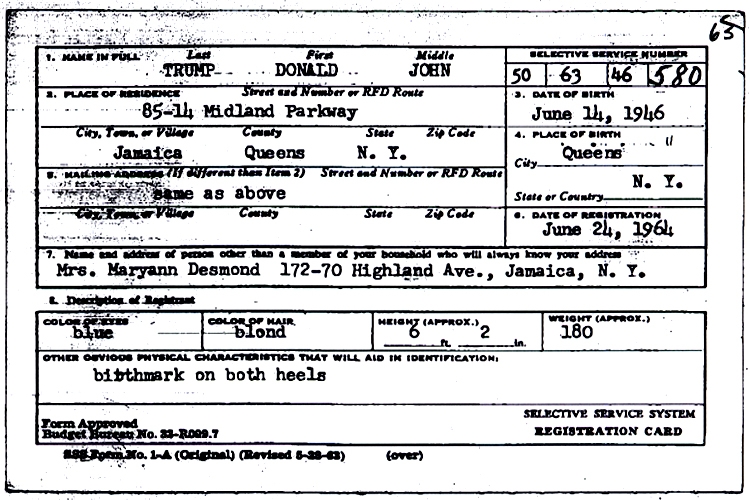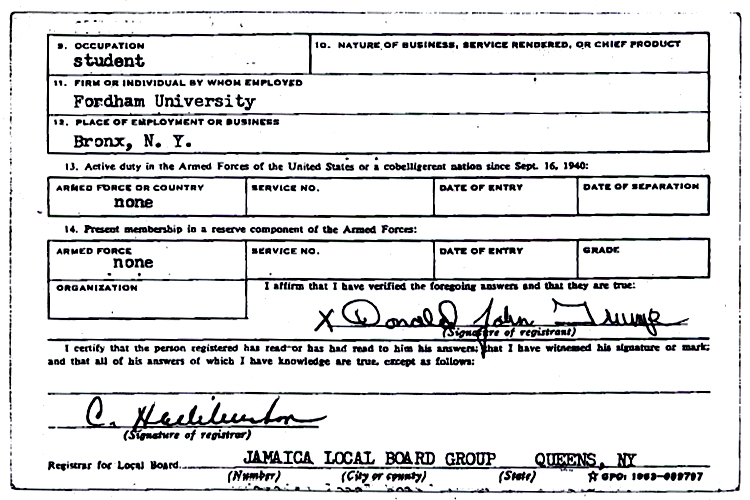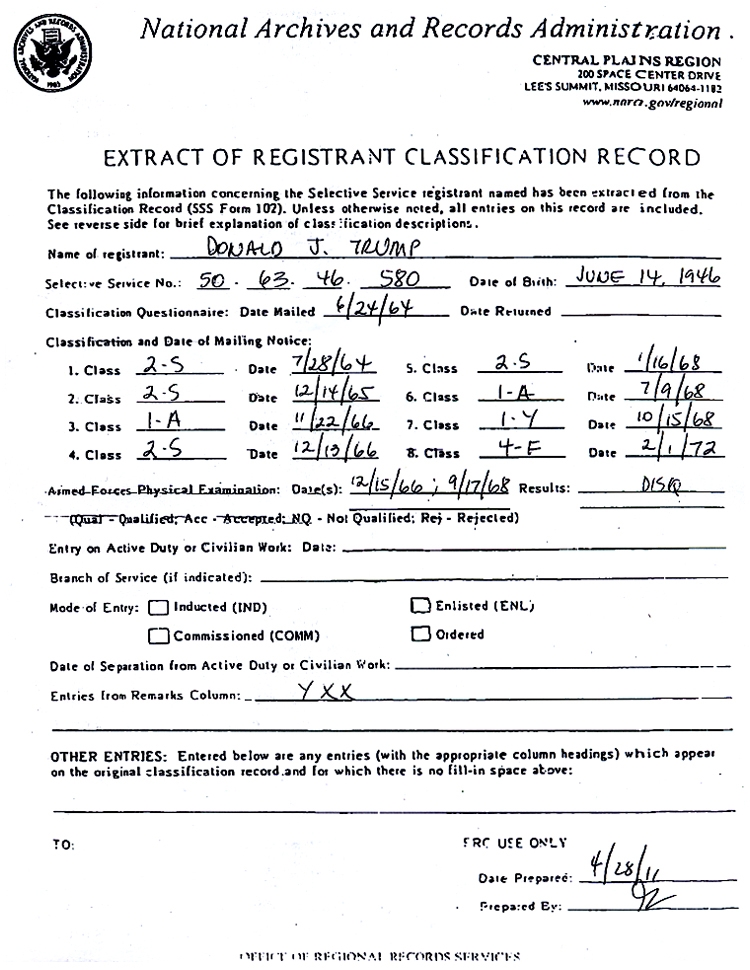

⬅ Donald Trump: Draft Records


This extract of Trump's draft records shows his various classifications over more than seven years. A more comprehensible narrative (scroll down) provides context.

Aside:
Uninformed speculation has suggested the "YXX" annotation indicates a diagnosis
of Klinefelter syndrome, in which there are three sex chromosomes, XXY, instead of
the normal two (XX or XY). In fact, YXX was a standard abbreviation in Selective Service
records of the Viet Nam era with this meaning:
Remarks Column: "yxx" -- these symbols indicate the registrant's physical, mental and administrative qualifications, in that sequence. A symbol with the letter "y" appearing in one of the three elements indicates that the registrant may be acceptable for service in the Armed Forces only in time of war or national emergency declared by Congress. Vietnam was not a declared war or national emergency by Congress. We have no record which provides the specific reason the registrant was found conditionally acceptable for service. 1
The ledger from Trump's local draft board shows numerous other records having the YXX annotation in its column 10 MORE.
The table below captures the important events in Trump's journey through the draft system.
The rightmost column is actually not about Trump. It is mostly made up. (A few items have references.) It is included because many readers will have no experience with the draft and would otherwise not understand the context of each of the events. The rightmost column attempts to explain how a person might be thinking if (a) they did not want to be drafted, and (b) they experienced the same events as Trump did.
| Date | Draft Classification |
Event | Thoughts of a Reticent Person (No one in particular) |
|
| 1964 18 |
June 14 | - | Turns 18 | All males must register for the draft at age 18. |
|---|---|---|---|---|
| June 24 | - | Classification questionnaire -- Mailed | ||
| July 28 | 2-S | Student deferment | Status 2-S is a "student deferment" that prevents me from being drafted into the military. As long as I'm in college, I can maintain the 2-S status and therefore cannot be drafted. | |
| September | Student at Fordham U. | |||
| 1965 19 |
Dec. 14 | 2-S | ||
| 1966 20 |
spring | Leaves Fordham | ||
| Nov. 22 | 1-A | Status 1-A makes me prime meat for being drafted. As soon as I am no longer in college, I lose my 2-A status. I need to return to college as soon as possible. If I never left college, and someone screwed up my paperwork, I need to fix that as soon as possible. | ||
| Dec. 13 | 2-S | Three weeks of jeopardy just ended. But all is good now that I have my 2-S (student) classification re-instated. I just have to stay in college and hope the war ends soon. | ||
| Dec. 15 | Physical examination | At some point a military doctor examines me in person, to see if I am physically qualified to serve in the military should I be drafted. I would like him to find something that disqualifies me, but even if he doesn't I still have my student deferment (2-S) working, so there is no immediate jeopardy. | ||
| 1967 21 |
||||
| 1968 22 |
Jan. 16 | 2-S | ||
| May 20 | Graduates from college 2 | Trump claims he watched the draft lottery while a college student at Wharton, but this is demonstrably false. The first such lottery in the Viet Nam era occurred 18 months after Trump graduated. 3 | ||
| July 9 | 1-A | It has been four years since I registered for the draft. The war continues. I have finished college. My student deferment has therefore ended. I could go to graduate school and continue a 2-S student deferment, but I just can't stomach that. Now, because I passed my military physical exam back in December 1966, I have been given a 1-A status and am prime meat to be drafted and sent to Viet Nam. This is serious jeopardy. 1968 is becoming a big year for the war and for drafting men into the military. | ||
| Sep. 17 | Physical examination - Disqualified | Because a person's physical state can change over time, medical re-examination may be required. This is my chance to show the military physician that my physical state prevents me from serving in the military. A heel spur could prevent me from serving in the military. Information about a heel spur would be transmitted to the military in a physical examination like this. | ||
| Oct. 16 | 1-Y | The 1-Y status says that I am not to serve in the military unless every normally-eligible man has already been drafted. That would obviously be an extreme war or national emergency. Fortunately, it is very very unlikely that this war in Viet Nam is ever going to get that big, so this is excellent protection against the draft. A person with a heel spur could very reasonably be put into this 1-Y category, because heel spurs can impact the ability to march or walk long distances. | ||
| 1969 23 |
Dec. 1 | Draft number picked: 356 3 | The draft number applies to the persons in category 1-A, the men who are prime meat to be drafted. The draft number, which is assigned to your birthday by a lottery drawing, determines whether you are really prime, or not so prime. That is, the lower the number, the closer to the front of the line you are to be drafted. The highest (best) possible draft number is 366 because that puts you absolutely last in line among all the people in 1-A status. My number, 356, is based on my June 14 birthday, and is a superb number. It is almost as good as 1-Y status, because it means that, even if I had a 1-A classification, 97% of the 1-A men would have to be drafted before my turn would come. This is very good news. It means that even if my medical condition gets better, I am basically protected from being drafted. | |
| 1970 24 |
||||
| 1971 25 |
Dec. 10 | Policy change |
"The 1-Y classification was abolished December 10, 1971. Local boards were subsequently instructed to reclassify all 1-Y registrants by administrative action." 4 | |
| 1972 26 |
Feb. 1 | 4-F | For me, this 4-F status simply continues the protection I had in 1-Y status. The 4-F classification was used in World War II and thus is familiar to millions of Americans of all ages, almost like a word in the English language. | |
| 1973 27 |
Jan. 27 | Peace treaty. Draft ends. | No more conscriptions will occur. Now my draft status doesn't matter. | |
A pictorial view of Trump's draft classification status is below, designed to show the relative amount of time spent in each status over the time he was subject to the draft. The horizontal axis is to scale for the passage of time.
| Status | Years | Status Explanation | |||||||||
| 1-A | . | . | Fit to be drafted | ||||||||
| 1-Y | . | Qualified only in time of war or national emergency 4 | |||||||||
| 2-S | . | . | . | . | Student | ||||||
| 4-F | . | Unfit | |||||||||
| <-- 1964 | 1974 --> | ||||||||||
- Selective Service System. [Classification History: Donald J. Trump]. (Published [no date]. Downloaded on 2019-12-14.) Available on the web: https://www.washingtonpost.com/wp-stat/graphics/politics/trump-archive/docs/trump-deferment-history-from-selective-service.pdf
- Valania, Jonathan. Fact-Checking All of the Mysteries Surrounding Donald Trump and Penn. (Published 14 Sept. 2019. Downloaded on 2019-12-13.) Available on the web: https://www.phillymag.com/news/2019/09/14/donald-trump-at-wharton-university-of-pennsylvania/
- The Smoking Gun. Deferments Helped Trump Dodge Vietnam. (Published 18 July 2015. Downloaded on 2019-12-03.) Available on the web: http://www.thesmokinggun.com/documents/celebrity/deferments-helped-trump-dodge-vietnam
- Selective Service System. Classifications. (Published 4 September 2015. Downloaded on 2019-12-03.) Available on the web: https://www.sss.gov/Classifications
Comment: Obtained from The Smoking Gun reference.